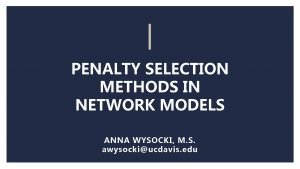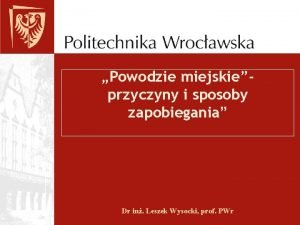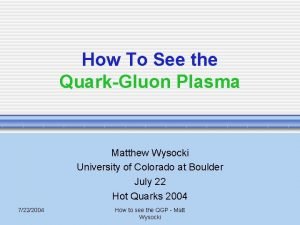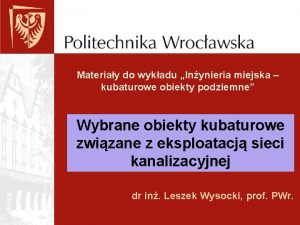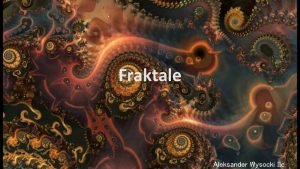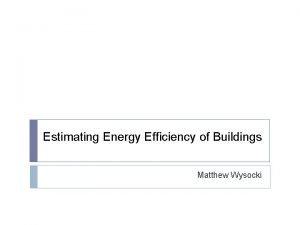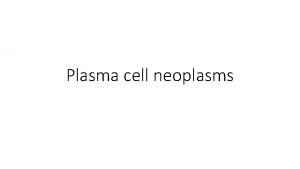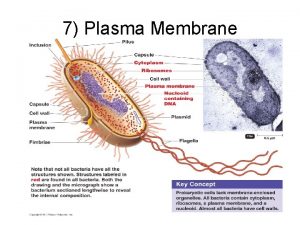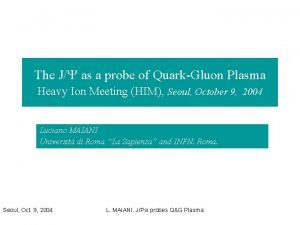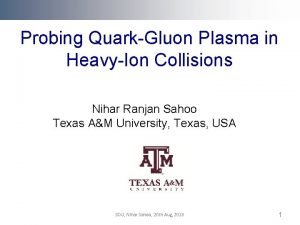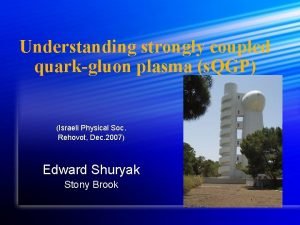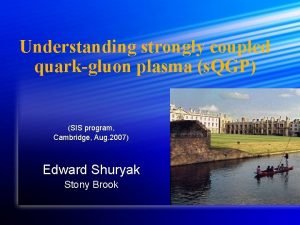How To See the QuarkGluon Plasma Matthew Wysocki










- Slides: 10

How To See the Quark-Gluon Plasma Matthew Wysocki University of Colorado at Boulder July 22 Hot Quarks 2004 7/22/2004 How to see the QGP - Matt Wysocki

The Quark-Gluon Plasma • The quark-gluon plasma is a hot, dense state of matter in which partons have become deconfined (within the region of the plasma) from the normal hadronic state. • Characterized by high energy density (e > few Ge. V/fm^3) and high temperature (T > 100 -200 Me. V) or baryon density (n > 0. 72/fm^3) relative to normal nuclear matter. 7/22/2004 How to see the QGP - Matt Wysocki 2

Signature Required Q: How can we tell the difference between states of matter? A: We need a signature to check! Proposed signatures include: 1. 2. 3. 4. 5. 7/22/2004 Dilepton production Photon production Hanbury-Brown-Twiss Effect Strange matter content J/Y suppression How to see the QGP - Matt Wysocki 3

Debye Screening • The charge of one particle is screened by the surrounding charges. • Debye Screening Radius (l. D): The distance at which the charge is reduced by 1/e. • Originally defined for electromagnetic plasma, later extended to plasma of color charges. 7/22/2004 These quarks effectively cannot “see” each other! How to see the QGP - Matt Wysocki 4

Charmonium and the J/Y • Charmonia ( ) states are represented fairly well (at T≈0) by the potential: • The energy equation is then: State Charmonia states as given in the Particle Data Book 7/22/2004 T=0 T=Tc Mass (Ge. V) hc 2. 98 J/Y 3. 1 cc 3. 4 -3. 5 Y’ 3. 7 -4. 4 But at T=Tc, a screening factor is introduced and k vanishes! How to see the QGP - Matt Wysocki 5

J/Y in the QGP Matsui & Satz (Phys. Lett. B 178 (1986) 416): In the QGP the screening radius could become smaller than the J/Y radius, effectively screening the quarks from each other! T=0 aeff 0. 52 T=200 0. 20 0. 41 fm 1. 07 fm ∞ 0. 59 fm From Introduction to High-Energy Heavy-Ion Collisions, C. Y. Wong 1994 7/22/2004 The quark and anti-quark become unbound, and are absorbed back into the medium or recombine with a light quark to emerge as “open charm” mesons. How to see the QGP - Matt Wysocki 6

J/Y Suppression! • In a QGP at T > Tc, we should see less J/Y’s than we would expect without the plasma (J/Y suppression). • Heavy ion collisions at RHIC are currently the best place to look for this. 7/22/2004 How to see the QGP - Matt Wysocki 7

Dilepton Backgrounds Drell-Yan Thermal dileptons Hadronic dileptons 7/22/2004 Dominant background in J/Y mass region and higher Dominated by Drell-Yan in heavy ion collisions such as those at RHIC. M emitted at Tc= 200 Me. V Q emitted at To = 300 Me. V OPEN CHARM!!! RHIC energies Provides background in low mass region (r, w, f) How to see the QGP - Matt Wysocki 8

Whoa there, cowboy… A lot has happened since Matsui & Satz: • J/Y suppression from other causes: w Nuclear absorption w Shadowing • J/Y enhancement! w Recombination • More recent lattice calculations show J/Ys remaining bound as high as 1. 5 Tc. 7/22/2004 How to see the QGP - Matt Wysocki 9

Summary • How hot? How much? • In the quark-gluon plasma, the J/Y bound state will still be suppressed. • High-energy heavy ion collisions (such as those at RHIC and the LHC) offer the best chance of observing this effect, and hence the QGP. 7/22/2004 How to see the QGP - Matt Wysocki 10

